|
|
|
Sort Order |
|
|
|
Items / Page
|
|
|
|
|
|
|
| Srl | Item |
| 1 |
ID:
171430
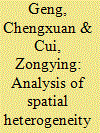

|
|
|
|
|
| Summary/Abstract |
The paper integrates the economics and geography theoretical methods, and takes the data of 119 Chinese A-share listed companies in the energy conservation and environmental protection industry from 2008 to 2017 as the research sample, analyzes the spatial heterogeneity of industrial capital allocation efficiency and its driving factors from the perspective of environmental regulation. The GWR model is constructed to study the effect of driving factors on the capital allocation efficiency of each province and visualize the spatial distribution state of driving factors. The results show that the capital allocation efficiency of China's energy conservation and environmental protection industry shows a trend of increasing volatility, but there are obvious spatial dynamic differences in different provinces. Environmental regulation has a significant positive impact on regional capital allocation efficiency and enhances the effect and spatial heterogeneity of other drivers. Infrastructure condition and financial development have a significant positive effect on regional capital allocation efficiency, and both tend to decline from east to west. While the government support has a low impact and the scope of fluctuation and spatial heterogeneity is small, indicating that the relevant government support policies still lack the pertinence and effectiveness of local conditions.
|
|
|
|
|
|
|
|
|
|
|
|
|
|
|
|
| 2 |
ID:
182788
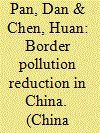

|
|
|
|
|
| Summary/Abstract |
This paper studies the effect of environmental regulations on border pollution reduction in developing countries' rural areas by taking livestock environmental regulations (LERs) in China as a quasi-natural experiment. Applying the generalized difference-in-difference-in-differences (DDD) method, we find that LERs are effective in reducing border pollution: the chemical oxygen demand (COD) and ammonia nitrogen (NH3−N) of the border counties are 21.78% and 39.51%, less than that of the interior counties. We document that the effectiveness of LERs in reducing border pollution can be attributed to the fact that LERs require local governments to make collective decisions in fighting livestock pollution. Further heterogeneity analysis finds that the reduction effect of LERs on border pollution is greater in the downstream border and underdeveloped areas. Our paper implies that the externality of border pollution can be internalized through collective decision-making between local governments.
|
|
|
|
|
|
|
|
|
|
|
|
|
|
|
|
| 3 |
ID:
092813
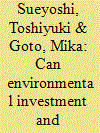

|
|
|
|
|
| Publication |
2009.
|
| Summary/Abstract |
This study investigates the causality from environmental investment (as a long-term effort) and expenditure (as a short-term effort) to financial performance in the US electric utility industry. The industry is one of the large air polluters in the United States. This empirical study finds that the environmental expenditure under the US Clean Air Act has had a negative impact from 1989 to 2001. The negative impact has become much effective after the implementation of the Title IV Program (1995) of the US Clean Air Act. This study cannot find the influence of environmental investment on financial performance by a statistical test although it indicates a positive impact. In the United States, fossil-fueled power plants such as coal-fired ones still produce a large portion of electricity. The generation structure is inconsistent with the betterment in the US environmental protection and imposes a financial burden to electric utility firms.
|
|
|
|
|
|
|
|
|
|
|
|
|
|
|
|
| 4 |
ID:
092336
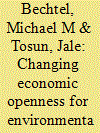

|
|
|
|
|
| Publication |
2009.
|
| Summary/Abstract |
Citizens' concerns about (international) environmental protection standards are of increasing importance to governments in industrially advanced, high-regulating countries. In almost any proposal for a trade agreement, countries with low environmental regulation standards are required to introduce higher policy standards in exchange for high-regulating countries dismantling their trade barriers and granting access to their domestic markets. Low-regulating countries often act as required and introduce legislation aimed at reducing pollution. This leads to declaratory or de jure policy convergence. But such legislative action is not always associated with de facto or actual policy convergence, since policies are not always enforced. To analyze the strategic aspect of this potential "slippage," we set up a game-theoretic model with imperfect information. In the model, a high-regulating and a low-regulating country negotiate a bilateral free trade agreement with environmental provisions. We show how potential gains from trade, policy enforcement, and reputation costs, as well as domestic demands for environmental protection affect the occurrence of environmental policy convergence through conditional trade agreements. This study thereby advances our understanding of the relationship between bilateral trade and convergence of environmental policies.
|
|
|
|
|
|
|
|
|
|
|
|
|
|
|
|
| 5 |
ID:
139153
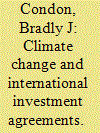

|
|
|
|
|
| Summary/Abstract |
This article analyzes how International Investment Agreements (IIAs) might constrain the ability of governments to adopt climate change measures. This article will consider how climate change measures can either escape the application of IIA obligations or be justified under exceptions. First, this article considers the role of treaty structure in preserving regulatory autonomy. Then, it analyzes the role that general scope provisions can play in excluding environmental regulation from the scope of application of IIAs. Next, this article will consider how the limited incorporation of environmental exceptions into IIAs affects their interpretation and application in cases involving environmental regulation. The article then analyzes non-discrimination obligations, the minimum standard of treatment for foreign investors and obligations regarding compensation for expropriation. This analysis shows that tribunals can exclude environmental regulation from the scope of application of specific obligations as well.
|
|
|
|
|
|
|
|
|
|
|
|
|
|
|
|
| 6 |
ID:
146892
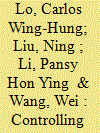

|
|
|
|
|
| Summary/Abstract |
This article traces the institutional development of environmental regulation in urban China, using data from three rounds of surveys of enforcement officials in the Guangzhou Environmental Protection Bureau in 2000, 2006 and 2013. We found that the changes to institutional contexts of regulatory control appear mainly in the fluctuating degree of support from various non-state actors, but not from government entities and regulated industries. While we detected visible organizational changes in local environmental enforcement bureaus, there was also organizational stability. First, the quality of enforcement officials has improved, as reflected by a higher level of education, first from 2000–2006 and then from 2006–2013. Second, the perceived value of enforcement officials in environmental protection was considerably enhanced in the period 2000–2006, and then remained stable from 2006 to 2013. Third, enforcement obstacles in terms of administrative ambiguity remained virtually unchanged from 2000 to 2013, while enforcement power deficit, resource scarcity and procedural ambiguity became more severe. Overall, the general perception of enforcement effectiveness at both the unit and organizational levels has remained the same over the past 13 years, whereas individual-level enforcement was perceived to have become more effective (with significant changes mainly taking place from 2006 to 2013). On the basis of these empirical results, we found that the institutional conditions for stricter enforcement in Guangzhou were visibly improved from 2000 to 2006, but only modestly improved between 2006 and 2013.
|
|
|
|
|
|
|
|
|
|
|
|
|
|
|
|
| 7 |
ID:
175009
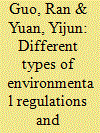

|
|
|
|
|
| Summary/Abstract |
Using China's provincial panel data during 2000–2017, this study attempts to research the impacts of different environmental regulatory instruments and relative stringency on total factor energy efficiency. A Super-SBM model with undesirable outputs is used to evaluate the energy efficiency of industrial sector for thirty provinces in China. The result indicates a relatively low energy efficiency of industrial sector and significant difference between provinces in China. The dynamic panel regression was employed to examine the heterogeneous effects and mechanisms on energy efficiency by different types of environmental regulations. We have two main findings: (1) At a certain stringency level, both command-and-control and market-based environmental regulations have positive effects on total factor energy efficiency. (2) There exist nonlinear relationships between environmental regulations and total factor energy efficiency. The current regulation level of command-and-control exceeds the optimal level, while the current regulation level of market-based is reasonable. Moreover, market-based environmental regulation is more effective based on China's reality. These findings provide new evidence in confirming the Porter effect and some policy implications for China to further improve energy efficiency.
|
|
|
|
|
|
|
|
|
|
|
|
|
|
|
|
| 8 |
ID:
176794
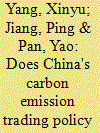

|
|
|
|
|
| Summary/Abstract |
The implementation of China's carbon emission trading policy has targeted achieving emission reduction and environmental protection as well as promoting economic development and technological innovation. The analysis is made through applying the Difference-in-Differences model and using the Ordinary Least Squares method and the Least Square Dummy Variable method in the paper. Results show that the pilot carbon emission trading policy leads to the expansion of employment scales and the reduction of carbon emissions after controlling for the environmental regulation, population size, economic level, and other important variables. Thus, it implies that an employment double dividend exists. For the Porter effect, it is found in the pilot carbon emission trading policy only without adding any control variable. The effect is further verified based on a robustness checks and a placebo test. Furthermore, from the perspective of market-oriented environmental regulation policy, this study explains that the carbon emission trading system launched in 2017 needs to be improved to spread both the employment double dividend and the Porter effect to the whole nation. China also needs to form a complete set of strict ecological environment protection policies and administrative measures to achieve sustainable development of the economy.
|
|
|
|
|
|
|
|
|
|
|
|
|
|
|
|
| 9 |
ID:
128027
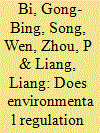

|
|
|
|
|
| Publication |
2014.
|
| Summary/Abstract |
Data envelopment analysis (DEA) has gained much popularity in performance measurement of power industry. This paper presents a slack-based measure approach to investigating the relationship between fossil fuel consumption and the environmental regulation of China's thermal power generation. We first calculate the total-factor energy efficiency without considering environmental constraints. An environmental performance indicator is proposed through decomposing the total-factor energy efficiency. The proposed approach is then employed to examine whether environmental regulation affects the energy efficiency of China's thermal power generation. We find that the environmental efficiency plays a significant role in affecting energy performance of China's thermal generation sector. Decreasing the discharge of major pollutants can improve both energy performance and environmental efficiency. Besides, we also have three main findings: (1) The energy efficiency and environmental efficiency were relatively low. (2) The energy and environmental efficiency scores show great variations among provinces. (3) Both energy efficiency and environmental efficiency are of obvious geographical characteristics. According to our findings, we suggest some policy implications.
|
|
|
|
|
|
|
|
|
|
|
|
|
|
|
|
| 10 |
ID:
112256
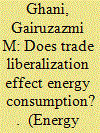

|
|
|
|
|
| Publication |
2012.
|
| Summary/Abstract |
The effect of trade liberalization on the environment can be directly linked to energy consumption, because energy consumption and production are the underlying cause of most pollutants that harm the environment. The descriptive statistics show that average annual growth of energy consumption per capita after trade liberalization varies among countries; hence it is a possibility that the effect of trade liberalization is conditional on factors other than liberalization per se. The regression results show that trade liberalization per se does not affect the growth of energy consumption of the developing countries analyzed, but its interaction with capital per labor reduces the growth of energy consumption as capital per labor increases. However, the effect is only significant after a certain minimum threshold level capital per labor is reached. On the other hand, economic growth increases energy consumption and its effect is not conditioned on trade liberalization. These two different effects mean that, with regards to energy consumption, countries at a higher level of economic development are more likely to reap the benefit of liberalization relative to less developed countries.
|
|
|
|
|
|
|
|
|
|
|
|
|
|
|
|
| 11 |
ID:
104965
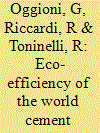

|
|
|
|
|
| Publication |
2011.
|
| Summary/Abstract |
Chemical reactions and the combustion of dirty fuels, such as coal and petroleum coke (petcoke), that are used in cement production processes generate a significant amount of CO2 emissions. In this paper, we provide an eco-efficiency measure for 21 prototypes of cement industries operating in many countries by applying both a data envelopment analysis (DEA) and a directional distance function approach, which are particularly suitable for models where several production inputs and desirable and undesirable outputs are taken into account. To understand whether this eco-efficiency is due to a rational utilization of inputs or to a real carbon dioxide reduction as a consequence of environmental regulation, we analyze the cases where CO2 emissions can either be considered as an input or as an undesirable output. Empirical results show that countries where cement industries invest in technologically advanced kilns and adopt alternative fuels and raw materials in their production processes are eco-efficient. This gives a comparative advantage to emerging countries, such as India and China, which are incentivized to modernize their production processes.
|
|
|
|
|
|
|
|
|
|
|
|
|
|
|
|
| 12 |
ID:
137694
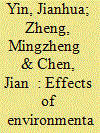

|
|
|
|
|
| Summary/Abstract |
Based on environmental Kuznets curve theory, a panel data model which takes environmental regulation and technical progress as its moderating factors was developed to analyse the institutional and technical factors that affect the path of low-carbon economic development. The results indicated that there was a CO2 emission Kuznets curve seen in China. Environmental regulation had a significant moderating effect on the curve, and the inflection of CO2 emissions could come substantially earlier under stricter environmental regulation. Meanwhile, the impact of technical progress on the low-carbon economic development path had a longer hysteresis effect but restrained CO2 emission during its increasing stage and accelerated its downward trend during the decreasing stage which was conducive to emission reduction. Strict environmental regulation could force the high-carbon emitting industries to transfer from the eastern regions to the central or the western regions of China, which would make the CO2 Kuznets curve higher in its increasing stage and lower in its decreasing stage than that under looser regulation. Furthermore, energy efficiency, energy structure, and industrial structure exerted a significant direct impact on CO2 emissions; we should consider the above factors as essential in the quest for low-carbon economic development.
|
|
|
|
|
|
|
|
|
|
|
|
|
|
|
|
| 13 |
ID:
112297
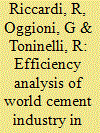

|
|
|
|
|
| Publication |
2012.
|
| Summary/Abstract |
CO2 emissions reduction and energy efficiency improvement are the targets of many environmental policies that aim at tackling climate change. The European Emission Trading is the best example of this engagement against climate change. Considering this framework, this paper studies the efficiency of the high energetic and CO2 emissions intensive cement production process in 21 world countries. Alternative formulations of standard data envelopment analysis models and a directional distance function approach are compared in order to detect the efficiency of the cement sector both in presence and in absence of carbon emissions. We first analyze the entire cement production process and we then concentrate on the production of clinker, a by-product of cement, that is the main responsible of CO2 emissions. Our results show that the inclusion or the exclusion of undesirable factors (CO2) influence efficiency levels as well as the investments in new technologies and the utilization of alternative fuels and raw materials in the cement and clinker production processes.
|
|
|
|
|
|
|
|
|
|
|
|
|
|
|
|
| 14 |
ID:
166469
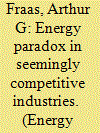

|
|
|
|
|
| Summary/Abstract |
Several federal agencies claim the existence of an energy paradox in competitive markets in their benefit-cost analyses: firms fail to use energy-saving equipment that on net would reduce their costs. Such findings appear incompatible with neoclassical views that private firms in competitive markets will seek to minimize costs. EPA and NHTSA (2016) justify their findings in part by claiming that owners of trailers pulled by others underinvest in energy-saving equipment because the trailer owners incur the costs of such investments while tractor owners get the benefits. We collected roadside data over three summers and model use of energy-saving equipment on trailers. We find associations consistent with cost-reducing behavior in the use of energy efficiency devices, such as skirts and automatic tire inflation devices, but no evidence that different ownership of tractors and trailers is associated with reduced use of energy-saving equipment on trailers. We recommend that EPA and NHTSA assess the in-use cost-effectiveness of such equipment and rigorously review the empirical basis for claims of market failures in competitive markets before claiming significant private economic gains in rulemakings.
|
|
|
|
|
|
|
|
|
|
|
|
|
|
|
|
| 15 |
ID:
186956
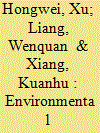

|
|
|
|
|
| Summary/Abstract |
Previous studies of place-based policies in China have ignored their effect on pollution. Using event study and difference-in-differences methodologies, we investigated the consequences of place-based policies on sulfur dioxide (SO2) emissions. We first documented the increase in SO2 emissions and SO2 emission intensity in the inland region after 2003 at the provincial level. The firm-level data for the period between 1998 and 2010 also showed that the performance of enterprises in noneastern regions in reducing SO2 emissions had worsened relatively since 2003, and this effect was particularly strong in enterprises located in central and northeast China, where urban land supply experienced significant growth after 2003. We found that, compared with environmental regulation changes, inland region-biased economic policies after 2003 were more important in explaining the relative changes in SO2 emissions between coastal and inland regions. The policy implication is that the central government should address environmental consequences when designing place-based economic policies.
|
|
|
|
|
|
|
|
|
|
|
|
|
|
|
|
| 16 |
ID:
186472
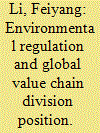

|
|
|
|
|
| Summary/Abstract |
Based on the CEPII BACI six-digit import and export product data from 2009 to 2019 and the WDI database of the World Bank, this paper uses the bilateral stochastic frontier analysis model to calculate the global value chain (GVC) bargaining power index of 131 countries or regions in the world, and measure their GVC division position. This paper also uses an environmental performance index to represent the intensity of environmental regulation. A panel data model is then established to test the impact of environmental regulations on GVC division position. The results show that: (1) Environmental regulation has an inverted U-shaped nonlinear effect on GVC division position, which initially increases and then decreases; (2) The mechanism is that appropriate environmental regulation can promote scientific and technological progress, but that strict environmental regulation can inhibit scientific and technological progress; (3) The effect of environmental regulation on GVC division position only occurs in regions of poorly developed countries, during the period of global economic change after 2012, and in polluting industries.
|
|
|
|
|
|
|
|
|
|
|
|
|
|
|
|
| 17 |
ID:
167001
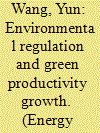

|
|
|
|
|
| Summary/Abstract |
Green growth has become an important development strategy for OECD countries and governments have correspondingly implemented various environmental regulation policies, whereas few studies have discussed the impacts of environmental regulation on green productivity growth in OECD countries. Based on a panel data of OECD countries' industrial sectors, this study analyzes the stringency of environmental regulation policies and measures green productivity growth using an extended SBM-DDF approach. The dynamic panel regression investigates the impacts and mechanism of environmental policy stringency on green productivity growth in OECD countries’ industrial sectors. The main results are: (i) Porter hypothesis is validated that the environmental policy has a positive impact on green productivity growth within a certain level of stringency (lower than 3.08); (ii) The impact turns to be adverse when the environmental regulation policy is stringent over a certain level, as the compliance cost effect is higher than innovation offset effect. The findings provide new empirical evidence for the strong version of the Porter Hypothesis and some implications for OECD countries to further promote green growth.
|
|
|
|
|
|
|
|
|
|
|
|
|
|
|
|
| 18 |
ID:
187919
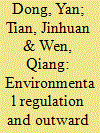

|
|
|
|
|
| Summary/Abstract |
This paper explores the impact of environmental regulation (ER) on outward foreign direct investment (FDI) flows in China. During the period from 2013 to 2015, all Chinese cities were required to join a nationwide automatic air quality monitoring network in batches, and this policy exogenously raised local environmental regulation. This unique policy implemented full coverage through a staggered adoption, which motivates this paper to apply an event study approach to identify the treatment effect of stringent environmental regulation. Based on a city-year level capital outflows dataset constructed from the fDi Markets database, we obtain three main findings: (1) environmental regulation significantly stimulates outward FDI flows; (2) this promoting effect centers on polluting industries; and (3) these ER-induced FDI outflows are mainly directed toward countries with weaker environmental protection and with a closer geographic and cultural distance to the home country. These results together provide a snapshot confirming the classical “pollution haven hypothesis”.
|
|
|
|
|
|
|
|
|
|
|
|
|
|
|
|
| 19 |
ID:
175239
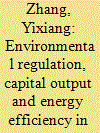

|
|
|
|
|
| Summary/Abstract |
How to improve environmental quality and achieve high-quality development of economy have become important challenges for China in the new era. Based on the KLEMS framework, this paper analyzes the relationship between environmental regulation, factor substitution, and energy-saving effect by using panel structure vector autoregression model and panel data of China industry from 2004 to 2014. The following conclusions are drawn:(1) China's environmental regulation can promote the substitution of capital to energy, however, benefit of this substitution in the long run is greater than that in the short run. (2) Only in the long run can China's environmental regulations have significant energy-saving effect, technological innovation is the main reason for the improvement of energy-saving effect of environmental regulation. (3) China's environmental regulation will not significantly improve the structure of capital, which makes the economic benefits low. Finally, the paper discusses the possible ways to improve China's environmental regulation from the aspects of forming a scientific environmental supervision system, improving energy pricing mechanism and capital structure.
|
|
|
|
|
|
|
|
|
|
|
|
|
|
|
|
| 20 |
ID:
182768
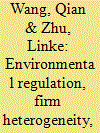

|
|
|
|
|
| Summary/Abstract |
We describe a model with firm heterogeneity and endogenous pollution abatement to show how emission intensity and exit/entry selections vary across firms. Using Chinese firm-level emission and production data, we find evidence that low productivity firms have higher emission intensity. The emission intensity of firms with productivity below 10 percentile is 5.26 times larger than firms with productivity above 90 percentile. Combining the Annual Survey of Chinese Industrial Enterprises (CIE) data, and applying a triple-difference research design, we find that firms with high emission intensity or low productivity have a higher probability of exit when exposed to strict environmental policy. We also find the exit of unproductive firms contributes to aggregate productivity and strict environmental policy can help to reduce misallocation.
|
|
|
|
|
|
|
|
|
|
|
|
|
|
|
|
|
|
|
|
|